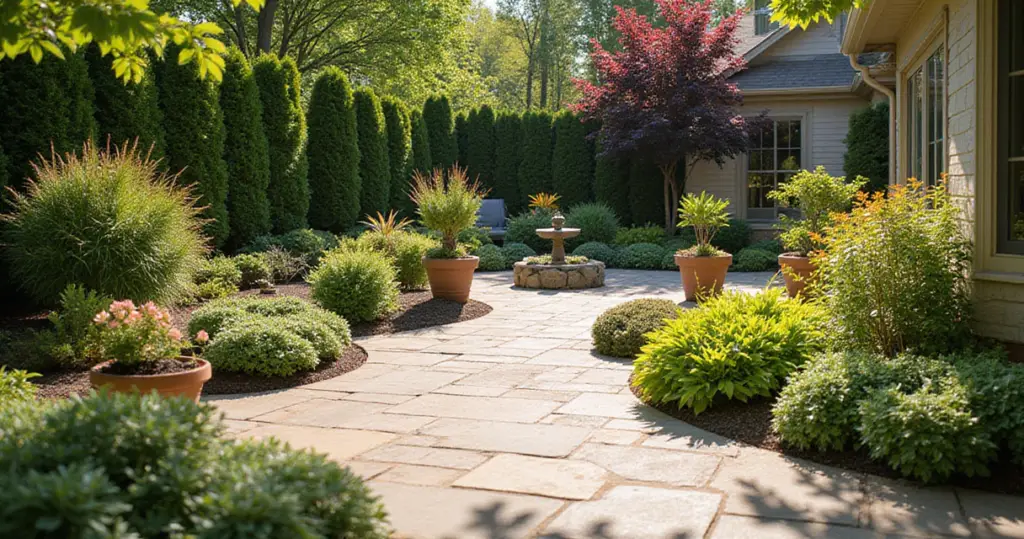Picture stepping onto your patio and being greeted by lush greenery, vibrant blooms, and the gentle sound of water trickling from a small fountain. Your outdoor space doesn’t have to remain a stark concrete slab or cluttered storage area. With thoughtful planning and strategic design choices, even the smallest patio can become a thriving garden sanctuary that rivals any indoor living room in comfort and beauty.
As a lighting design specialist who’s worked on countless residential projects, I’ve witnessed firsthand how the right combination of plants, lighting, and layout can completely transform an outdoor space. The key lies in understanding your patio’s unique characteristics – its sun patterns, microclimates, and potential for both day and evening use. These patio garden ideas aren’t just about adding plants; they’re about creating an integrated outdoor living experience that extends your home’s functionality while connecting you with nature.
Whether you’re working with a sprawling suburban deck or a compact urban balcony, these 21 patio garden ideas will guide you through every aspect of transformation. From maximizing natural light exposure to creating intimate evening retreats, each strategy builds upon proven design principles that enhance both aesthetics and functionality. Let’s explore how to turn your outdoor space into the garden oasis you’ve always envisioned.
1. Assess Your Space for Optimal Light and Layout
The foundation of any successful patio garden begins with understanding your space’s light patterns and physical constraints. This critical first step determines which plants will thrive, where to position seating areas, and how to maximize your patio’s potential throughout the day. Unlike indoor spaces where artificial lighting can compensate for poor natural light, outdoor gardens depend entirely on understanding and working with existing sun exposure patterns.
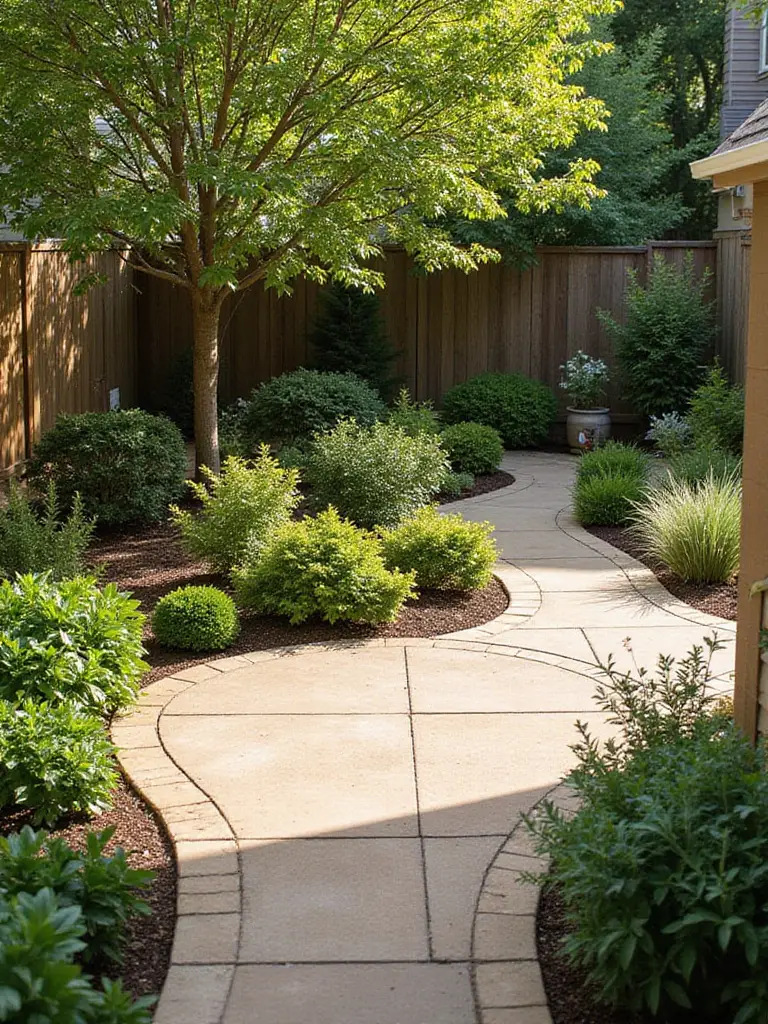
Start by conducting a comprehensive sun audit over several days, noting which areas receive full sun (6+ hours), partial sun (4-6 hours), or shade (less than 4 hours). Document these patterns hourly, as shadows shift dramatically throughout the day and seasons. Simultaneously, measure your patio’s dimensions and mark fixed elements like doors, water spigots, electrical outlets, and any structural features that could support vertical gardens or hanging plants. This mapping exercise reveals opportunities you might otherwise miss and prevents costly mistakes like placing sun-loving plants in perpetually shaded corners.
Understanding your patio’s light patterns can increase plant survival rates by up to 90% compared to random placement. Consider a north-facing urban balcony that initially seemed unsuitable for vibrant gardening – by carefully mapping its limited morning sun exposure and selecting shade-tolerant ferns and begonias, the space transformed into a lush green retreat. The key insight here: every patio has potential when you match plants to their ideal conditions rather than forcing incompatible combinations.
Look closely and you’ll notice the subtle variations in microclimates even within a small patio space, setting the stage for strategic container selection.
2. Choose Containers That Enhance Both Function and Style
Container selection forms the backbone of successful patio gardening, directly impacting plant health while establishing your space’s visual character. The right containers provide adequate root space, proper drainage, and aesthetic cohesion that transforms a collection of pots into a curated garden display. This choice is particularly crucial for patio garden ideas since containers become permanent fixtures that must perform functionally while complementing your outdoor design vision.
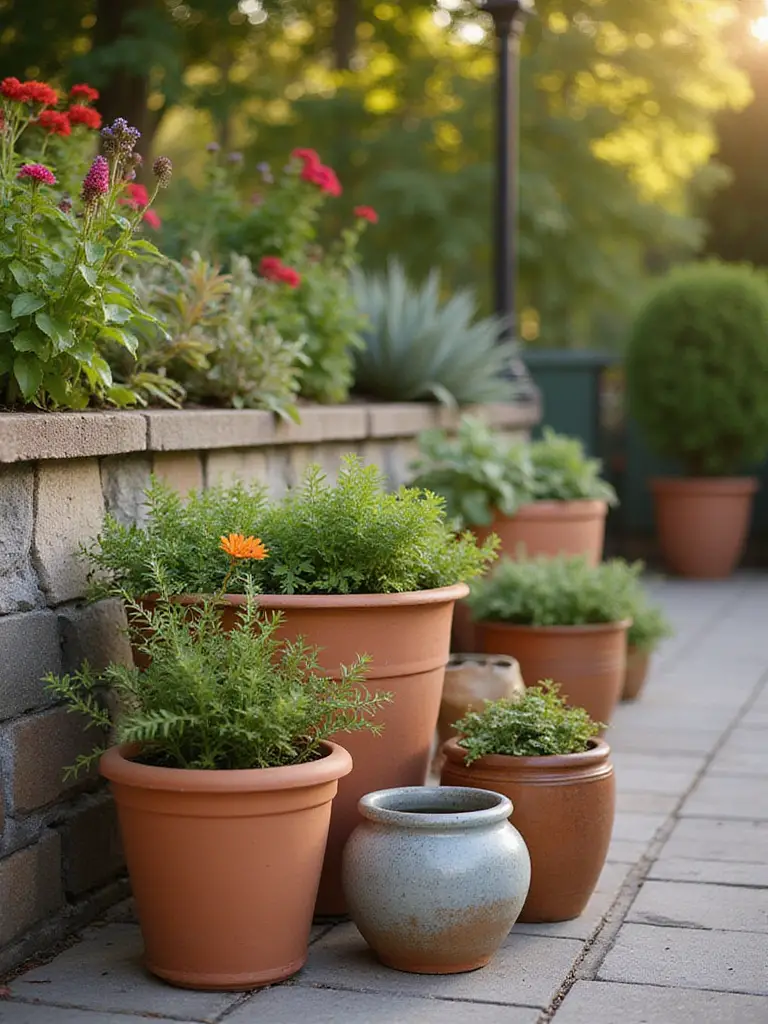
When selecting containers, prioritize drainage above all else – even the most expensive plants will fail if their roots sit in waterlogged soil. Every container needs adequate drainage holes, typically one large hole or several smaller ones, with pot feet or risers to improve air circulation. Consider material impact on watering frequency: unglazed terracotta requires 30% more frequent watering than glazed ceramic or plastic due to evaporative cooling, while lightweight fiberglass offers durability without weight restrictions for balcony gardens.
Create visual interest through varied container heights, textures, and materials while maintaining a cohesive color palette. Group containers in odd numbers (3, 5, 7) for the most pleasing arrangements, and ensure each pot is appropriately sized for its plant’s mature root system. A rooftop garden in Chicago achieved stunning results using lightweight, dark grey fiberglass planters of varying heights, housing drought-tolerant ornamental grasses and succulents. The consistent color palette unified the design while different sizes created dynamic visual rhythm across the space.
- Size considerations: Tomatoes need 5+ gallon containers, herbs thrive in 1-gallon pots, and dwarf fruit trees require 15+ gallon containers
- Material benefits: Terracotta provides excellent breathability, plastic retains moisture longer, and fiberglass offers durability with lighter weight
- Drainage essentials: Add gravel layers, use pot feet for elevation, and never use saucers that trap standing water
The magic of container gardening lies in creating the perfect growing environment from the ground up, starting with quality potting mix.
3. Select Premium Potting Mix for Thriving Root Systems
Quality potting mix serves as the foundation for container garden success, providing the precise balance of drainage, aeration, and moisture retention that plants need to thrive in confined spaces. Unlike dense garden soil, premium potting mixes are engineered to maintain their structure in containers, preventing compaction while ensuring roots receive adequate oxygen. This investment in quality growing medium can increase plant vigor by 40% and dramatically reduce common container gardening failures like root rot and stunted growth.

Professional-grade potting mixes typically contain 50-70% pore space, with roughly half filled with water and half with air after irrigation. Look for blends containing organic matter (peat moss or coir), aeration components (perlite or vermiculite), and slow-release fertilizers. Avoid cheap “potting soil” products that often contain heavy topsoil unsuitable for containers. The University of California Cooperative Extension emphasizes that physical properties matter more than nutrient content for initial plant success – proper structure promotes faster root establishment and healthier long-term growth.
Never compact potting mix when filling containers; instead, fill loosely and allow natural settling through initial watering. Leave approximately one inch of space from the container rim to prevent overflow during irrigation. A patio gardener struggling with wilting petunias despite frequent watering discovered their cheap potting soil stayed consistently soggy. Switching to a premium container mix rich in perlite and coir immediately revived the plants, which developed vibrant blooms within two weeks due to improved root oxygenation.
- Key ingredients to seek: Peat moss or coir for moisture retention, perlite for drainage, vermiculite for aeration
- Red flags to avoid: Heavy topsoil, excessive sand content, lack of organic matter
- Long-term maintenance: Refresh top few inches annually, completely replace every 2-3 years
Beyond horizontal space, the most innovative patio garden ideas utilize vertical dimensions to multiply growing potential.
4. Maximize Space Through Vertical Garden Systems
Vertical gardening revolutionizes small-space cultivation by utilizing wall surfaces, railings, and vertical structures to dramatically increase planting capacity without sacrificing valuable floor space. This approach is particularly valuable for compact patios where every square foot matters, allowing gardeners to cultivate diverse plant collections that would otherwise require much larger areas. Vertical systems can achieve 10-20 times the yield per square meter compared to traditional horizontal planting for leafy greens and herbs.
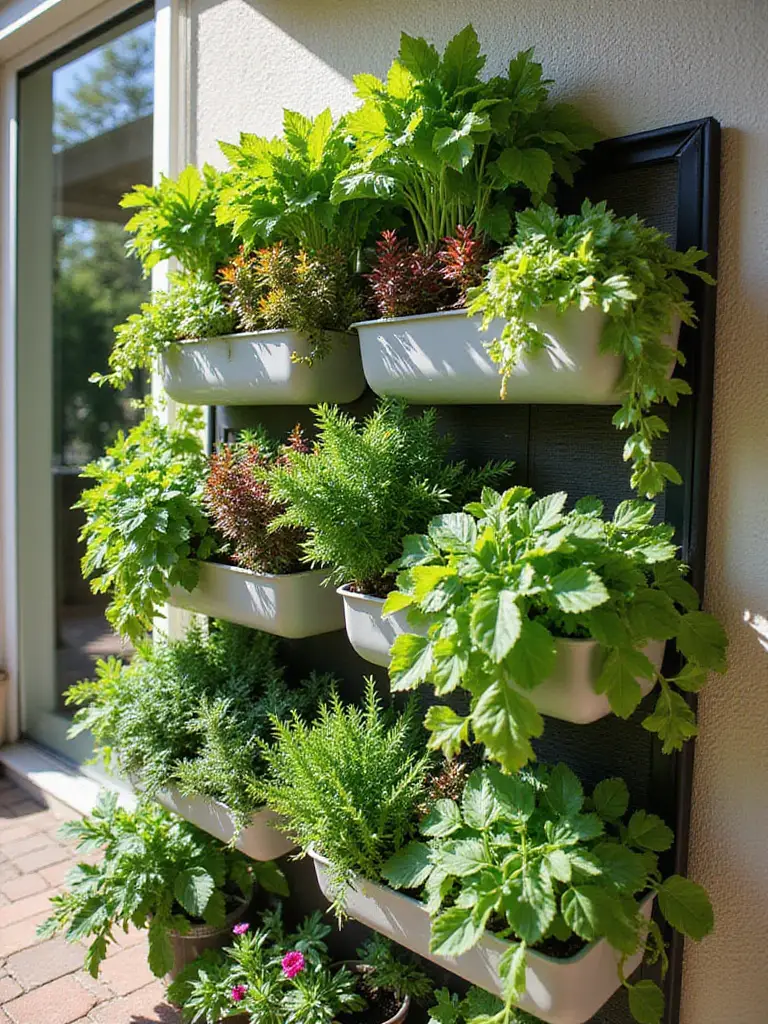
Choose vertical systems based on your wall’s structural capacity and sun exposure patterns. Options include wall-mounted pocket planters for herbs, modular panel systems for larger installations, or simple trellises supporting climbing plants. Ensure your chosen wall can safely support the combined weight of system, soil, and plants when fully saturated with water. A 5×7 foot Brooklyn patio utilized a modular felt pocket system covering one wall, successfully growing over 20 varieties of herbs, cherry tomatoes, and strawberries, effectively adding 35 square feet of growing space.
Select plants with shallow root systems and compact growth habits for vertical success. Excellent choices include herbs (basil, thyme, mint), leafy greens (lettuce, spinach), strawberries, and trailing flowers. Implement consistent watering systems since vertical gardens dry faster due to increased air exposure – drip irrigation or self-watering mechanisms work best. A Portland cafe installed tiered stacking planters creating a vibrant focal point that enhanced ambiance while providing natural privacy screening without requiring ground footprint.
- Ideal vertical plants: Herbs, leafy greens, strawberries, trailing petunias, small peppers
- Structural requirements: Wall must support 15-20 pounds per square foot when saturated
- Irrigation solutions: Drip systems, self-watering planters, or dedicated daily hand-watering schedules
What makes vertical gardens truly spectacular is how they integrate with cohesive design themes that unify your entire outdoor space.
5. Create Cohesive Themes That Tell Your Garden’s Story
Themed garden design transforms random plant collections into purposeful, emotionally resonant outdoor spaces that reflect personal style while creating immersive experiences. Whether embracing Mediterranean warmth, Zen tranquility, or modern minimalism, consistent themes guide plant selection, material choices, and decorative elements toward unified aesthetic goals. This approach reduces decision fatigue by 30-40% while ensuring every addition enhances rather than detracts from your overall vision.
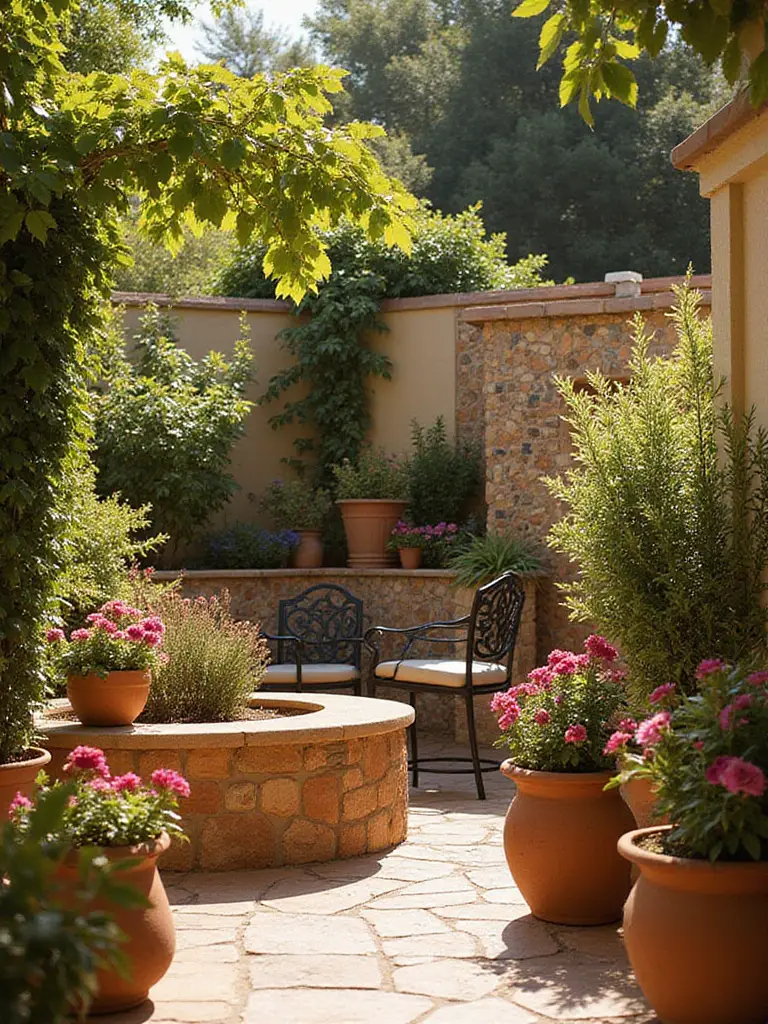
Begin by defining your desired mood and researching visual examples of your chosen theme. Mediterranean gardens feature drought-tolerant plants, terracotta containers, and warm color palettes, while Zen designs emphasize clean lines, limited color schemes, and plants with strong architectural forms. Consider your climate’s compatibility with theme requirements – desert themes work naturally in arid regions, while tropical themes may require more maintenance in temperate zones. Well-designed themed landscapes can increase property values by 150-200% of landscaping investment costs.
Implementation requires attention to spatial arrangement, color coordination, and material consistency. A Scottsdale patio achieved stunning “Desert Oasis” results using permeable gravel, drought-tolerant succulents, large terracotta planters, and a subtle water feature, reducing water usage by 60% while creating year-round visual appeal. Similarly, a small city patio transformed into a “Mediterranean Courtyard” using terracotta tiles, potted citrus trees, fragrant lavender, and wrought iron furniture, maximizing limited space to create an intimate, vacation-like atmosphere.
- Popular themes: Mediterranean (warm, drought-tolerant), Zen (minimal, architectural), Tropical (lush, colorful), Modern (geometric, monochromatic)
- Theme elements: Plant selection, container materials, color palettes, decorative accents, lighting styles
- Climate considerations: Choose themes compatible with local weather patterns for easier maintenance
The designer’s secret here is to seamlessly blend beauty with functionality by incorporating edible elements that serve both aesthetic and culinary purposes.
6. Integrate Edible Plants for Beauty and Bounty
Incorporating edible plants into patio designs creates living pantries that provide fresh ingredients while contributing to overall garden beauty. This approach transforms patio garden ideas from purely ornamental to functionally productive, offering the satisfaction of harvesting homegrown food steps from your kitchen. Even small container gardens can supply significant portions of household herb and salad green needs throughout growing seasons, with potential annual savings of $500-1,000 depending on scale and crop selection.
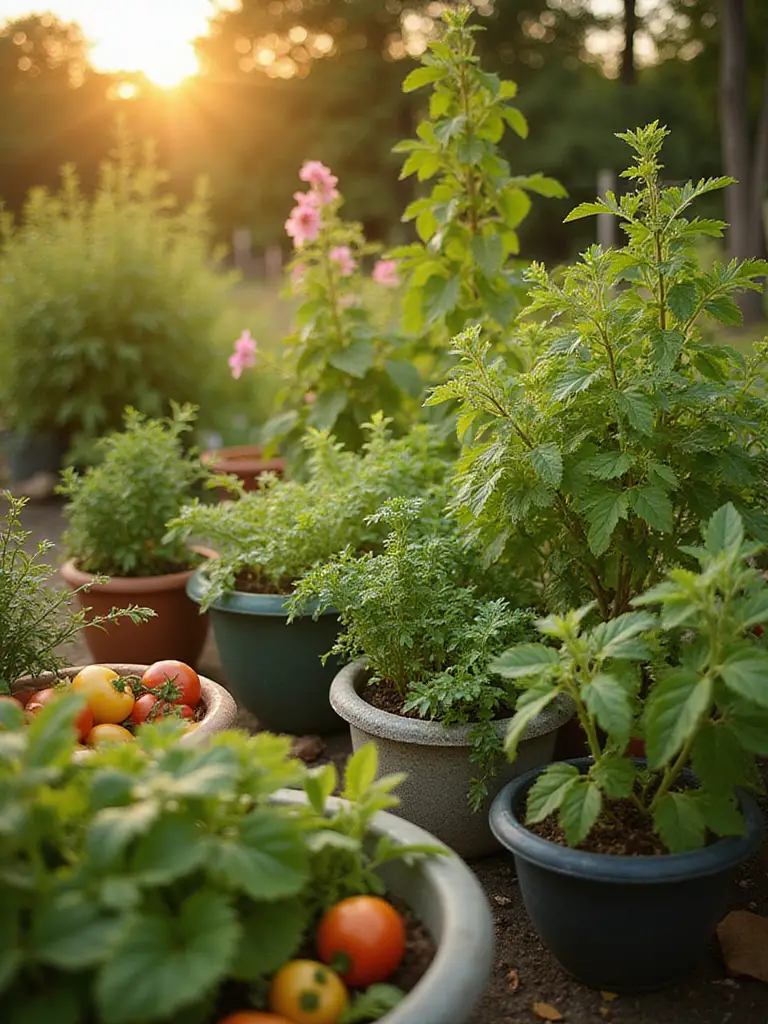
Assess sun exposure requirements for different edible categories – fruiting vegetables like tomatoes and peppers need 6-8 hours direct sunlight, while herbs and leafy greens thrive with 4-6 hours. Select compact, bush, or dwarf varieties specifically bred for container cultivation: ‘Patio’ tomatoes, ‘Lunchbox’ peppers, and various herbs perform exceptionally in confined spaces. Use appropriately sized containers with excellent drainage – fabric grow bags, self-watering planters, and large terracotta pots work well for different plant types.
Establish consistent care routines including regular watering, balanced organic fertilization, and frequent harvesting to encourage continued production. A couple transformed their 50-square-foot balcony into a productive mini-farm using vertical planters and fabric grow bags, harvesting enough fresh produce to supplement 60% of their salad and herb needs from May through October. Another family created a “pizza garden” featuring San Marzano tomatoes, bell peppers, basil, and oregano, providing all fresh ingredients for weekly homemade pizzas.
- High-yield container crops: Cherry tomatoes, herbs, leafy greens, bush beans, compact peppers
- Container size requirements: 5+ gallons for tomatoes, 1-3 gallons for herbs, 2-4 gallons for leafy greens
- Succession planting: Sow lettuce and radishes every 2-3 weeks for continuous harvests
Running your hand across this material reveals how mixing different textures and heights creates visual compositions that engage multiple senses.
7. Layer Textures and Heights for Dynamic Visual Appeal
Strategic layering of plant textures and container heights transforms flat, monotonous arrangements into dynamic focal points that draw the eye and create depth within patio spaces. The classic “Thriller, Filler, Spiller” principle provides a proven framework: tall, dramatic plants serve as vertical anchors, mounding plants fill middle space with color and texture, while trailing plants soften container edges with graceful cascades. This approach satisfies the eye’s natural desire for variety while maintaining organized visual hierarchy.
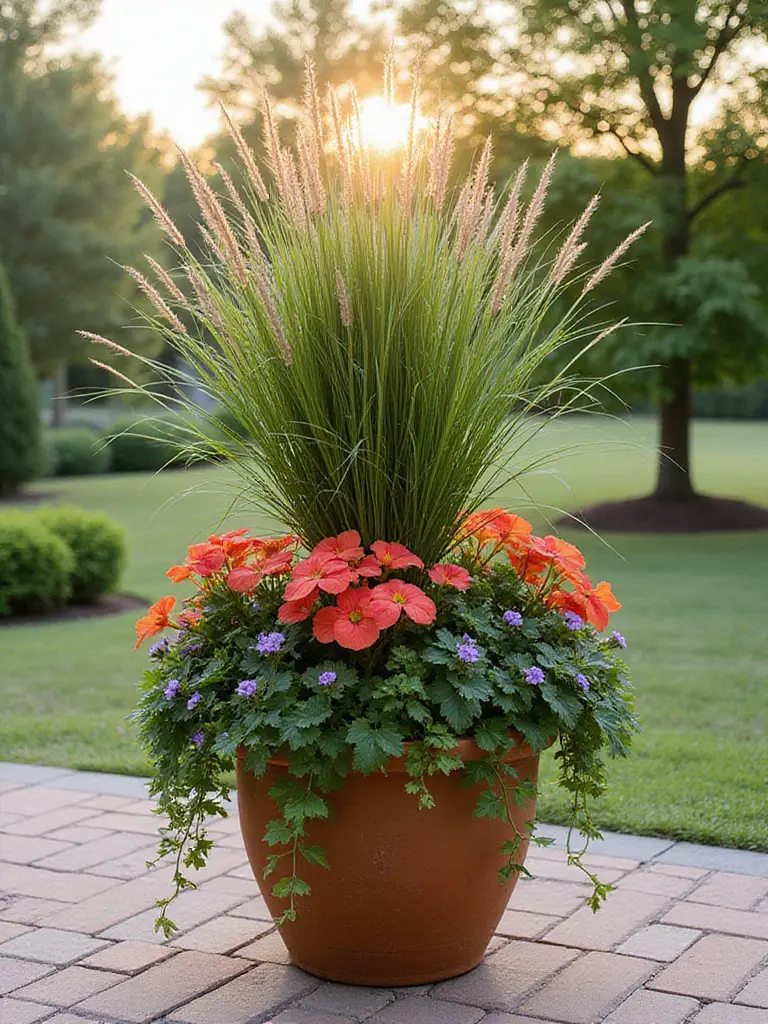
Select thriller plants with strong vertical presence – ornamental grasses, canna lilies, or dwarf Alberta spruce provide excellent focal points. Surround these with filler plants offering contrasting foliage textures and colors: broad-leafed coleus, mounding petunias, or variegated heuchera add volume and visual interest. Complete compositions with spiller plants that cascade over container edges: sweet potato vine, creeping jenny, or trailing calibrachoa create flowing elements that soften hard container lines.
Vary container materials and sizes to enhance textural diversity beyond plant selections. Combine rough terracotta with smooth glazed ceramic or sleek metal planters for multi-layered visual interest. A contemporary arrangement might feature dwarf Alberta spruce (thriller) with variegated Heuchera ‘Palace Purple’ (filler) and golden Sedum ‘Angelina’ (spiller) in a black metal planter, providing year-round interest with sophisticated modern aesthetics. Well-designed container gardens can increase home perceived value by 7-15%, with enhanced curb appeal being a top factor for potential buyers.
- Thriller options: Ornamental grasses, small trees, architectural succulents, tall flowering plants
- Filler choices: Mounding annuals, colorful foliage plants, compact perennials
- Spiller varieties: Trailing petunias, ivy, sweet potato vine, creeping groundcovers
The interplay between colors creates opportunities to embrace water-wise gardening through drought-tolerant plant selections.
8. Embrace Water-Wise Gardening with Drought-Tolerant Plants
Drought-tolerant plants represent the future of sustainable patio gardening, offering stunning beauty while dramatically reducing water consumption and maintenance requirements. These specially adapted species thrive with minimal irrigation once established, featuring characteristics like silvery foliage, waxy leaf coatings, succulent tissues, or deep root systems that conserve moisture. Residential outdoor water use accounts for 30% of household consumption (up to 60% in arid regions), making water-wise plant choices both environmentally and economically beneficial.
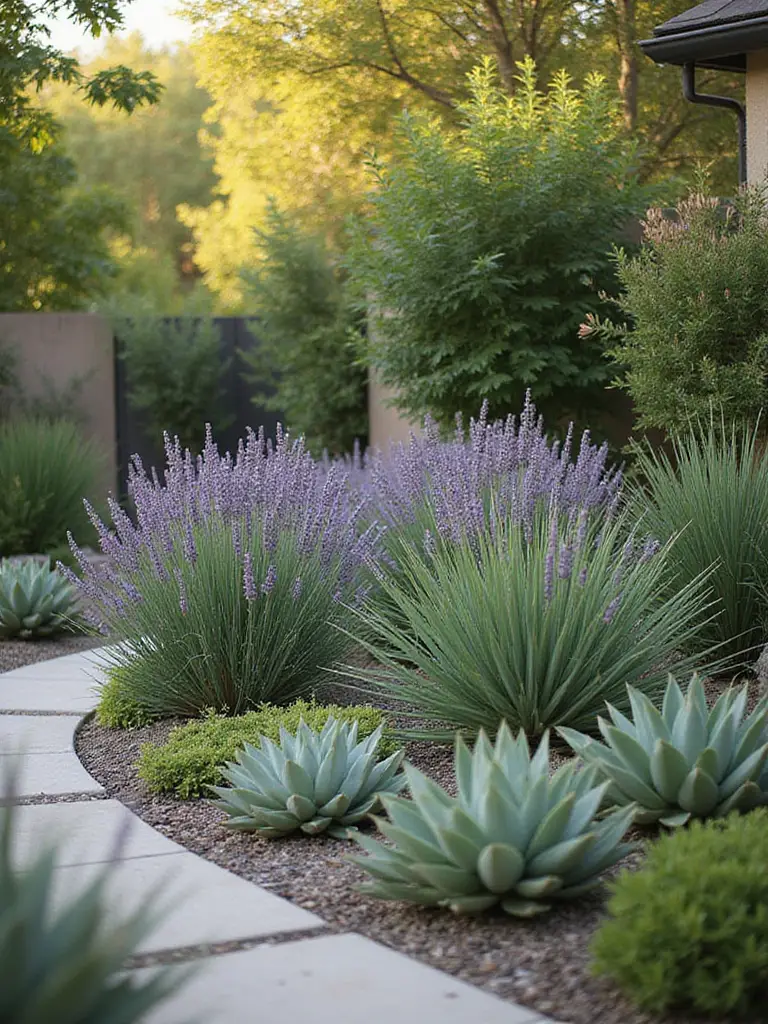
Research your specific climate zone to select regionally appropriate drought-tolerant species. Excellent choices include Mediterranean herbs (lavender, rosemary, sage), succulents (sedum, agave, echeveria), and native wildflowers adapted to local rainfall patterns. These plants often provide surprising diversity in textures, colors, and forms, defying stereotypes of “barren” xeriscapes. A Phoenix homeowner replaced water-intensive annuals with native succulents and desert perennials, achieving 70% reduction in summer water bills while maintaining vibrant, low-maintenance beauty.
Optimize growing conditions by ensuring excellent drainage – drought-tolerant plants are paradoxically susceptible to root rot in overly wet conditions. Amend container potting mix with perlite, pumice, or coarse sand to improve drainage. Water newly planted specimens regularly for initial establishment, then gradually reduce frequency to encourage natural drought resilience. Converting 500 square feet of traditional landscaping to water-wise design can save up to 8,800 gallons annually, illustrating substantial conservation potential.
- Drought-tolerant favorites: Lavender, sedum, agave, rosemary, salvia, ornamental grasses
- Water-saving features: Silvery foliage, waxy coatings, succulent tissues, deep roots
- Establishment period: Regular watering first 4-6 weeks, then gradual reduction to natural rainfall
The unexpected pairing that always works is combining water conservation with sensory richness through fragrant plant selections.
9. Engage the Senses with Fragrant Garden Elements
Fragrant plants transform patios from visual experiences into multi-sensory retreats that engage smell alongside sight, creating deeper emotional connections and enhanced relaxation benefits. Strategic placement of aromatic species near seating areas, pathways, and gathering spaces maximizes scent impact while contributing to overall garden beauty. Scientific research links specific fragrances like lavender and jasmine to measurably lower cortisol levels and improved sleep quality, making fragrant gardens genuinely therapeutic.
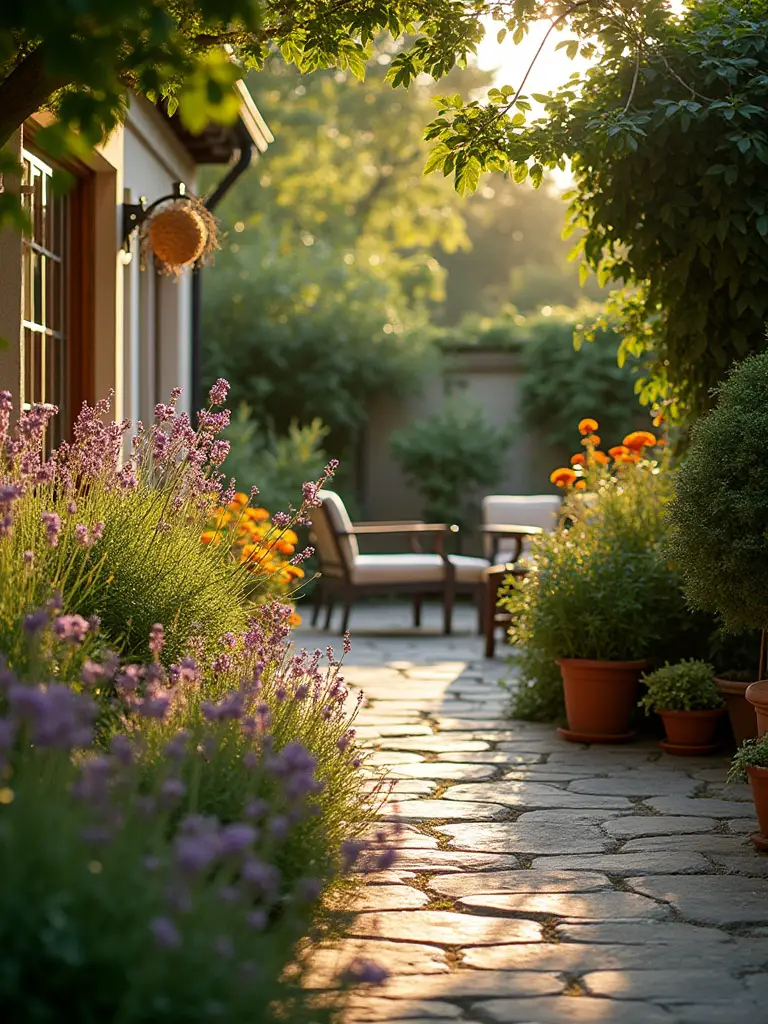
Select plants based on desired scent profiles and blooming periods to ensure continuous fragrance throughout growing seasons. Consider both daytime and evening bloomers: roses and herbs provide daytime aromatics, while night-blooming jasmine and moonflower intensify after dusk for evening patio use. Position highly fragrant plants at nose level through hanging baskets, elevated planters, or vertical gardens where their scents can be most appreciated without overwhelming smaller spaces.
Container cultivation offers flexibility to move fragrant plants where their scent is most desired or relocate them indoors during colder months. An urban dweller installed vertical garden panels featuring sweet pea and heliotrope near their dining table, creating evolving fragrances that significantly increased evening patio use and drew frequent guest compliments. Another homeowner lined their patio perimeter with lavender and gardenia in large terracotta pots, creating continuous calming aromas that reduced perceived street noise while naturally deterring mosquitoes.
- Daytime fragrance: Roses, herbs, sweet alyssum, stock, dianthus
- Evening bloomers: Night-blooming jasmine, moonflower, four o’clocks, evening primrose
- Placement strategies: Near seating areas, along pathways, at nose level in vertical arrangements
Beyond the obvious placement, consider using trailing plants to create cascading greenery that softens architectural elements.
10. Soften Hard Edges with Cascading Plant Arrangements
Trailing plants serve as nature’s softening agents, transforming rigid container edges and harsh architectural lines into organic, flowing compositions that feel more natural and inviting. These “spiller” elements in container arrangements create graceful cascades that draw the eye downward while adding movement and texture to static patio features. Strategic use of trailing plants can reduce the appearance of rigid container edges by up to 80%, creating more organic, garden-like aesthetics even in highly structured patio spaces.
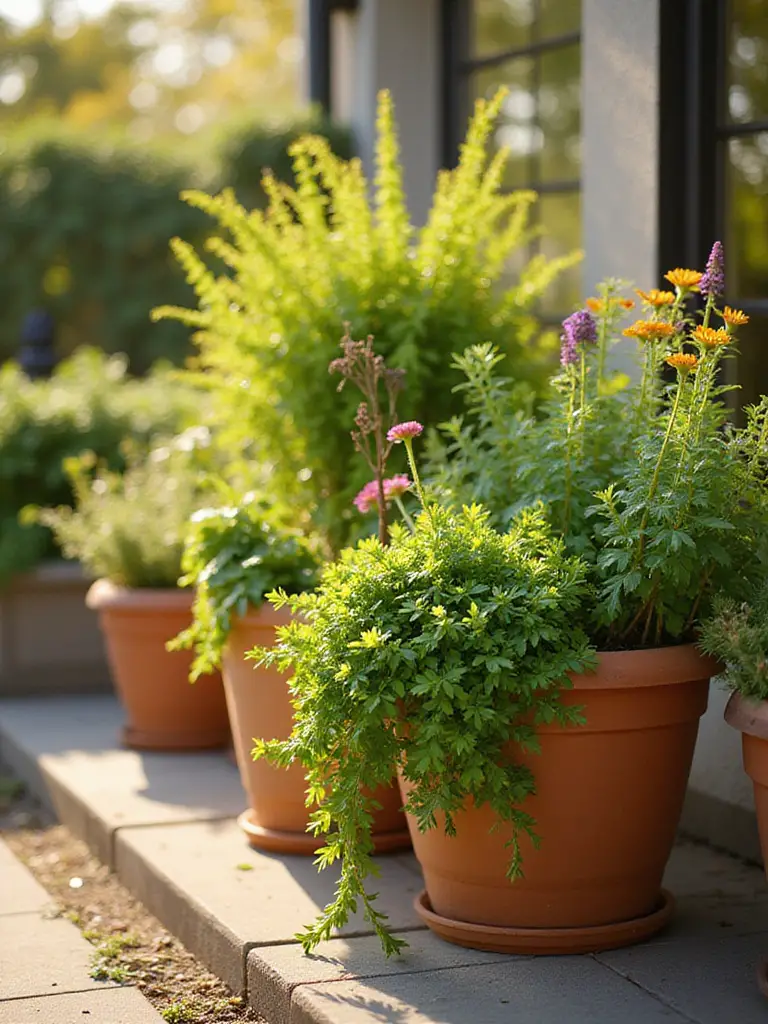
Select trailing varieties suited to your specific light conditions and aesthetic preferences. Sun-loving options include vibrant petunias, colorful calibrachoa, and cheerful sweet potato vine, while shade-tolerant choices encompass elegant English ivy, delicate bacopa, and bright creeping jenny. Position these plants at container fronts or edges where they have adequate space to cascade freely without being overshadowed by taller companion plants.
Maximize cascading effects through elevated placement using plant stands, tiered shelving, or hanging basket systems that provide greater vertical drop distances. Regular maintenance including consistent watering and periodic pruning encourages bushier, fuller growth while maintaining desired shapes. An urban balcony transformed its stark concrete railing using window boxes planted with chartreuse sweet potato vine that cascaded 2-3 feet downward, creating a lush privacy screen that reduced railing harshness by 60% while naturally cooling the space through evapotranspiration.
- Sun-loving trailers: Petunias, sweet potato vine, calibrachoa, trailing verbena
- Shade-tolerant options: English ivy, bacopa, creeping jenny, trailing begonias
- Elevation techniques: Plant stands, tiered shelving, hanging baskets, wall-mounted containers
As natural light filters through, the texture creates perfect conditions for extending your patio’s usability through strategic lighting design.
11. Extend Evening Enjoyment Through Strategic Lighting
Strategic outdoor lighting transforms patios from daytime-only spaces into versatile evening retreats, effectively doubling their usability while creating magical ambiance that rivals any indoor living area. Professional lighting design principles emphasize layering different light types – ambient for general illumination, task for specific activities, and accent for highlighting garden features – to create depth, functionality, and visual interest. LED outdoor lighting technology offers 75% energy savings compared to traditional incandescent options while lasting 25 times longer, making sophisticated lighting systems both environmentally and economically sustainable.
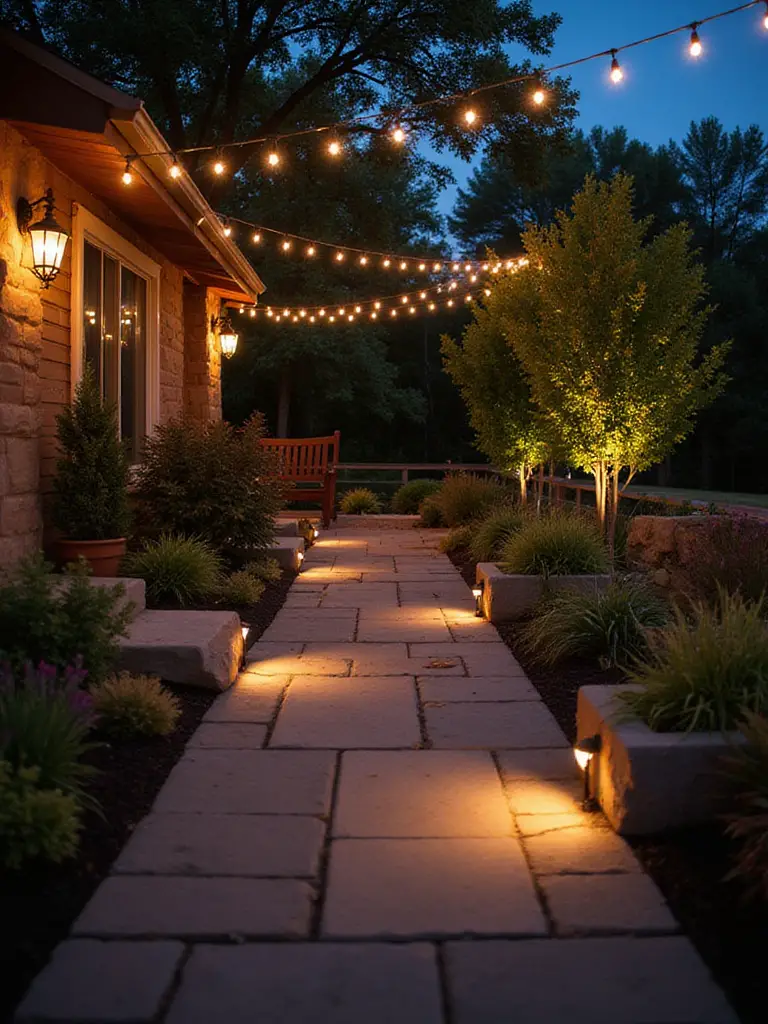
Plan lighting zones based on patio activities and desired moods. Ambient lighting through string lights or lanterns provides general illumination for conversation and relaxation, while task lighting near grilling or dining areas ensures functionality. Accent lighting can uplight specimen plants, illuminate water features, or highlight architectural elements. Consider smart lighting systems with dimming capabilities and automated scheduling to maximize versatility while optimizing energy consumption.
Power source selection affects installation complexity and ongoing costs. Low-voltage systems offer safer DIY installation, solar options eliminate wiring requirements while supporting sustainability goals, and smart controls enable app-based operation with scheduling capabilities. A Brooklyn patio utilized smart string lights in crisscross overhead patterns combined with uplights focused on potted olive trees, transforming unused evening space into a vibrant outdoor dining area used 4-5 nights weekly. Well-designed outdoor lighting can provide 50-70% return on investment through enhanced property value and extended living space functionality.
- Ambient options: String lights, lanterns, pathway lighting, general area illumination
- Task lighting: Grill lights, dining area fixtures, reading lamps for seating areas
- Accent features: Uplights for trees, water feature illumination, architectural highlighting
The visual weight balances perfectly when you create natural privacy barriers using living plant screens.
12. Design Living Privacy Screens for Intimate Outdoor Rooms
Plant-based privacy screens create natural barriers that block unwanted views, reduce noise pollution, and define intimate zones within patio spaces using living elements that enhance rather than detract from garden beauty. These green walls provide more sophisticated solutions than artificial screening while contributing to local ecosystems and air quality improvement. Dense evergreen plantings can reduce wind speeds by 50-70% while providing year-round screening, creating comfortable microclimates that extend patio usability across seasons.
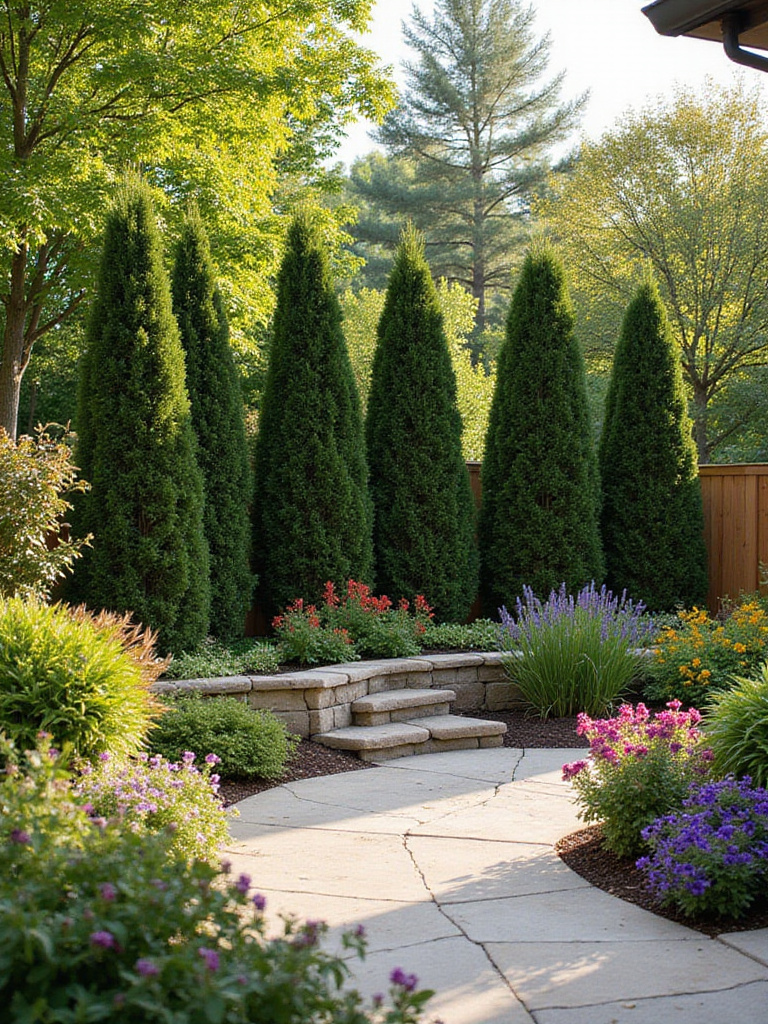
Assess specific privacy needs including required height, density, and screening duration (seasonal versus year-round) to guide plant selection. Fast-growing options like bamboo provide quick results, while evergreen shrubs offer permanent screening. Consider layered approaches using tall background plants, medium-height middle plantings, and lower foreground elements for more effective screening and visual interest. Native plant selections reduce maintenance requirements while supporting local wildlife and adapting naturally to regional climate conditions.
Installation requires careful attention to mature plant sizes, proper spacing for air circulation, and adequate root space in containers or raised beds. Establish consistent watering and fertilization schedules, especially during initial establishment periods when plants are developing strong root systems. An urban patio overlooking a busy street achieved effective screening using clumping bamboo in heavy planters combined with vertical garden systems, creating immediate visual barriers that reduced street noise and increased daily patio use within three months.
- Fast-growing options: Bamboo, privet, fast-growing evergreens, climbing vines on trellises
- Evergreen choices: Boxwood, holly, arborvitae, juniper for year-round screening
- Layered design: Tall background, medium middle, low foreground for depth and effectiveness
The composition comes together when you add the gentle sounds of water features to complete your sensory garden experience.
13. Create Tranquil Soundscapes with Water Features
Small water features transform patio environments by introducing soothing natural sounds that mask urban noise while creating focal points that enhance visual appeal and promote relaxation. The gentle sounds of flowing water effectively reduce perceived noise pollution while triggering measurable physiological responses – studies show water sounds decrease sympathetic nervous system activity by 25% while increasing parasympathetic activity by 20%, directly supporting stress reduction and mental well-being.
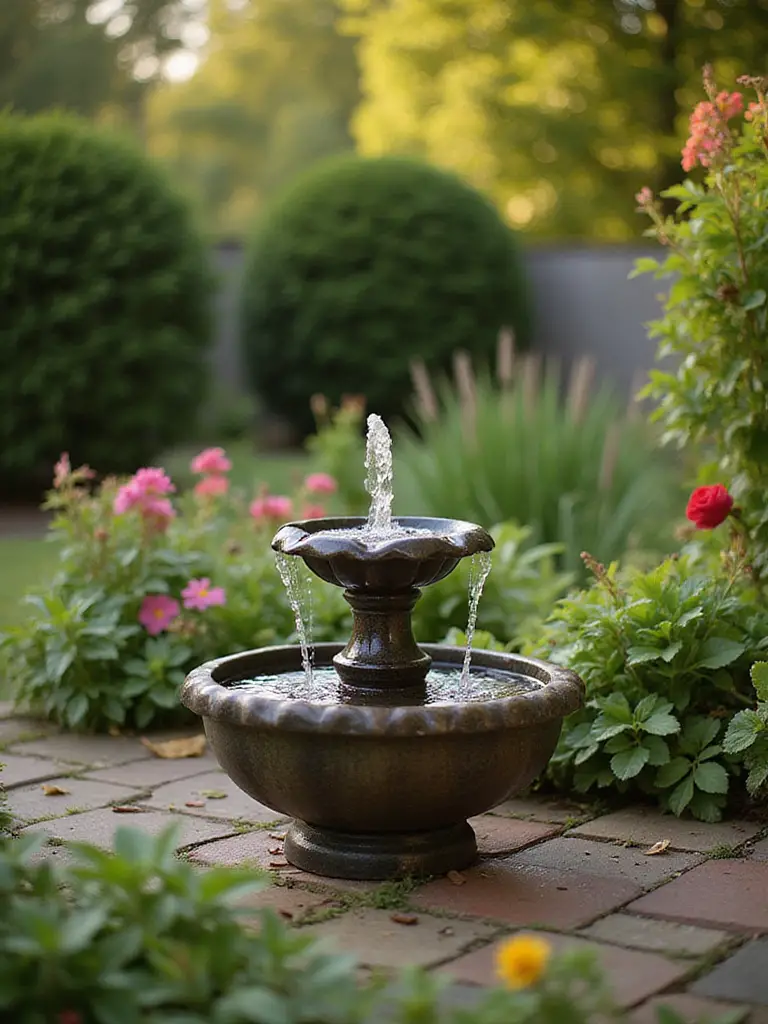
Select water features proportionate to your patio size and aesthetic preferences. Tabletop fountains work well for small spaces, while larger patios can accommodate bubbling rock formations or self-contained pond systems. Consider power requirements: electric pumps need outdoor-rated outlets, while solar-powered options eliminate wiring concerns. Position features near primary seating areas where sounds can be most appreciated, ensuring stable, level surfaces and convenient access for maintenance and water refills.
Customize water sounds through flow rate adjustments and strategic rock placement to achieve desired acoustic effects, from gentle trickling to more pronounced splashing. Regular maintenance includes monitoring water levels (especially during warm weather), cleaning pumps and filters, and winterizing systems in freezing climates. A homeowner installed a tiered resin fountain near their outdoor dining table, effectively masking street noise from a nearby busy road and creating peaceful conditions for outdoor meals and conversations, transforming a formerly noisy space into a serene retreat.
- Size options: Tabletop fountains, wall-mounted features, bubbling rocks, small ponds
- Power choices: Electric pumps with GFCI outlets, solar-powered systems, battery-operated options
- Sound customization: Adjustable flow rates, strategic rock placement, different fountain designs
The finishing touch that elevates the entire look comes from organizing your patio layout through strategic planter placement.
14. Organize Functional Zones Using Strategic Planter Placement
Strategic planter placement creates distinct functional zones within patio spaces without requiring permanent structural changes, effectively organizing outdoor areas into purposeful rooms that enhance usability and visual appeal. This approach utilizes containers as moveable architectural elements that define dining areas, lounging spaces, cooking zones, or quiet retreats while maintaining flexibility for seasonal adjustments or evolving needs. Professional landscape design increasingly emphasizes creating “outdoor rooms” that mirror indoor functionality, with 68% of homeowners prioritizing multi-functional patio spaces.
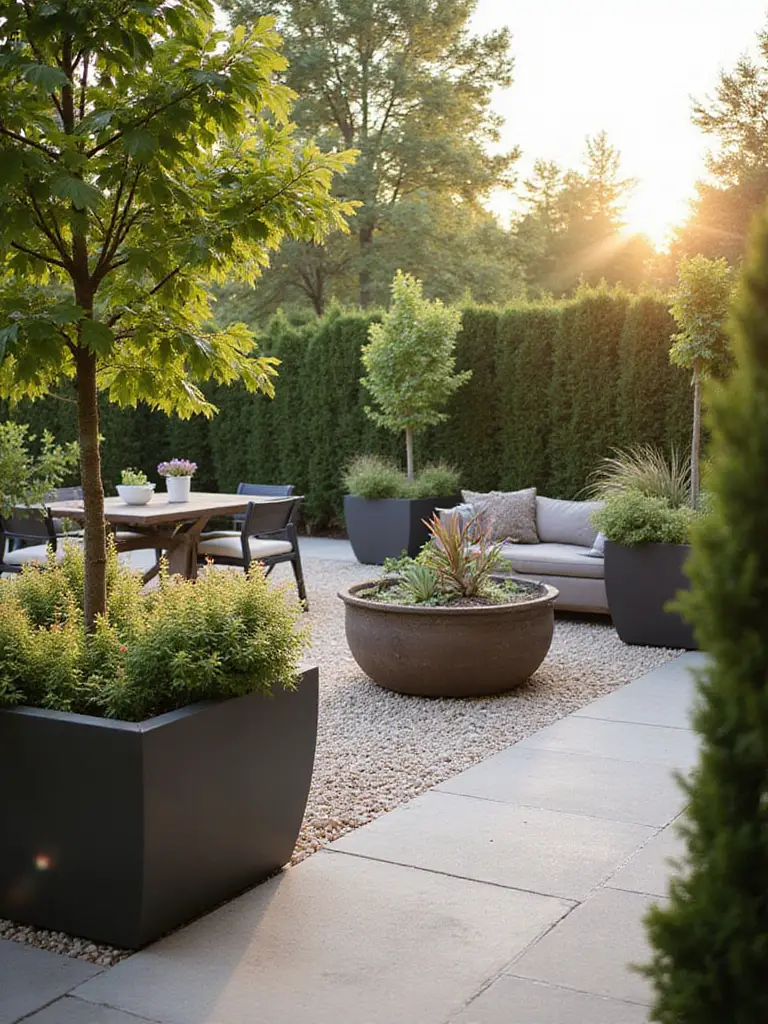
Map your patio dimensions and identify desired functional zones based on activities like dining, relaxation, cooking, or entertaining. Consider sun exposure patterns, existing structures, and natural traffic flow when positioning planters to create boundaries. Select appropriately scaled containers – tall, narrow planters work well for creating borders, while larger, lower containers can anchor seating areas. Ensure adequate spacing for comfortable movement between zones while maintaining clear sight lines and accessibility.
Choose plants that complement each zone’s function and aesthetic requirements. Privacy screening plants work well for separating dining from lounging areas, while aromatic herbs enhance cooking zones. Lighting integration within or around planters can further define zones for evening use. A 300-square-foot urban patio transformed from single open space into distinct dining and lounge areas using five 36-inch rectangular planters filled with bamboo arranged in an L-shape, doubling perceived utility and enabling simultaneous dining and relaxation activities.
- Zone types: Dining areas, lounging spaces, cooking zones, reading nooks, entertainment areas
- Container strategies: Tall planters for borders, low planters for anchoring, grouped arrangements for definition
- Plant selection: Privacy plants for screening, aromatic herbs for cooking areas, colorful displays for entertainment zones
Layer in dimension by simply adding comfortable seating that invites extended relaxation and outdoor living.
15. Create Comfort-Focused Seating Areas
Comfortable seating transforms patios from transitional spaces into destination outdoor rooms where people naturally want to spend extended time relaxing, entertaining, and connecting with nature. Quality outdoor furniture designed for comfort encourages longer patio use while supporting various activities from morning coffee to evening gatherings. The American Society of Landscape Architects reports 70% increased demand for comfortable outdoor living spaces, with seating being the primary factor determining patio usability and enjoyment.
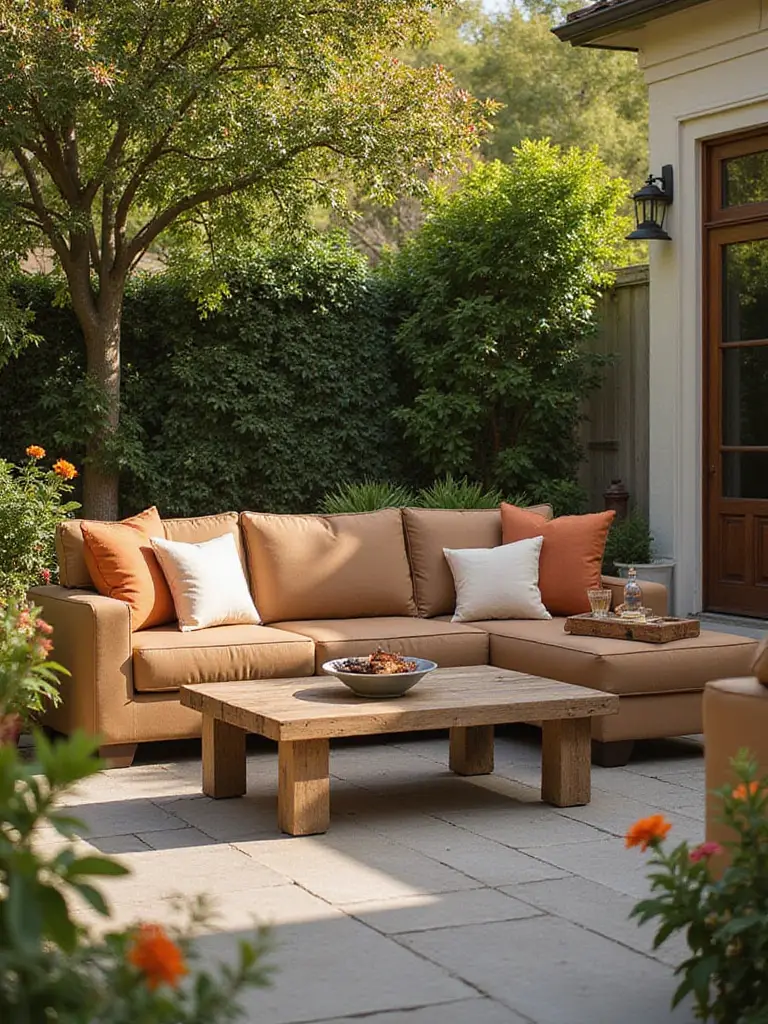
Select ergonomically designed furniture featuring deep seats, supportive backs, and weather-resistant construction materials like powder-coated aluminum, synthetic wicker, or marine-grade polymers. Measure your patio carefully to ensure adequate clearance – allow at least 3 feet around tables and between seating groups for comfortable movement. Consider modular options that can be reconfigured for different occasions, from intimate conversations to larger gatherings, maximizing patio versatility.
Layer comfort through high-quality, fade-resistant outdoor cushions, pillows, and throws that add softness while introducing color and texture. These textiles transform basic furniture into inviting seating that rivals indoor comfort levels. A small urban balcony became a cherished reading retreat with a single comfortable chaise lounge, side table, and weather-resistant pillows, increasing owner’s outdoor time by 5-7 hours weekly and significantly improving daily stress levels through regular nature connection.
- Furniture materials: Powder-coated aluminum, synthetic wicker, teak, marine-grade polymer
- Comfort features: Deep seats, supportive backs, ergonomic design, quality cushioning
- Configuration options: Modular pieces, conversation sets, individual lounge chairs, dining combinations
The styling mistake most people make is treating outdoor spaces as afterthoughts rather than extensions of their personal style through decorative elements.
16. Express Personal Style Through Curated Decorative Accents
Decorative accents transform generic patio spaces into personalized outdoor oases that reflect individual style while enhancing functionality and visual appeal. These elements bridge the gap between basic furniture and plants, adding character, color, and texture that make spaces feel curated and intentional. Strategic accent placement can increase perceived patio value and enjoyment while supporting various activities and moods throughout different seasons and occasions.
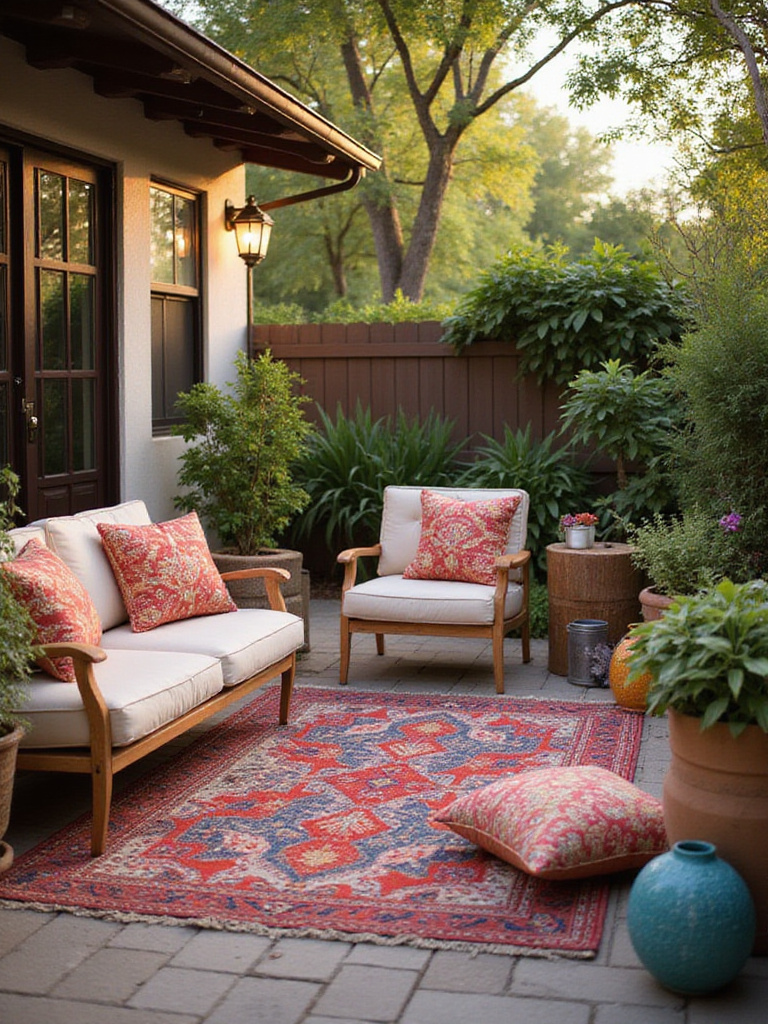
Define your aesthetic preferences and color palette before selecting accents to ensure cohesive design that complements existing furniture and architectural elements. Key accent categories include weather-resistant outdoor rugs for defining spaces, decorative throw pillows for comfort and color, ambient lighting for evening atmosphere, unique planters with varied textures, and outdoor art or sculptures for personality. Layer different materials like wicker, metal, ceramic, and various fabrics to create rich, tactile environments that engage multiple senses.
Consider scale and placement carefully – larger items anchor spaces while smaller details add visual interest and personality. Rotate seasonal elements like pillows, small planters, or decorative objects to keep spaces feeling fresh and aligned with changing weather or holidays. A small urban balcony transformed into a vibrant reading nook through a brightly patterned outdoor rug, cascading hanging planters, and solar fairy lights, increasing daily usage by 200% and creating a highly frequented personal retreat.
- Essential accents: Outdoor rugs, decorative pillows, ambient lighting, unique planters, weather-resistant art
- Material mixing: Combine wicker, metal, ceramic, and fabric textures for depth and interest
- Seasonal rotation: Swap pillows, small planters, and decorative elements to maintain freshness
The unexpected environmental benefit comes from implementing water-efficient irrigation systems that support plant health while conserving resources.
17. Implement Efficient Drip Irrigation Systems
Drip irrigation systems revolutionize patio garden maintenance by delivering water directly to plant roots through slow, controlled distribution that minimizes evaporation and runoff while ensuring consistent moisture levels. This technology can achieve 90% water use efficiency compared to 50-70% for sprinklers and often less than 50% for hand watering, making it both environmentally responsible and economically beneficial. Automated systems eliminate daily watering tasks while promoting healthier plant growth through consistent moisture availability.
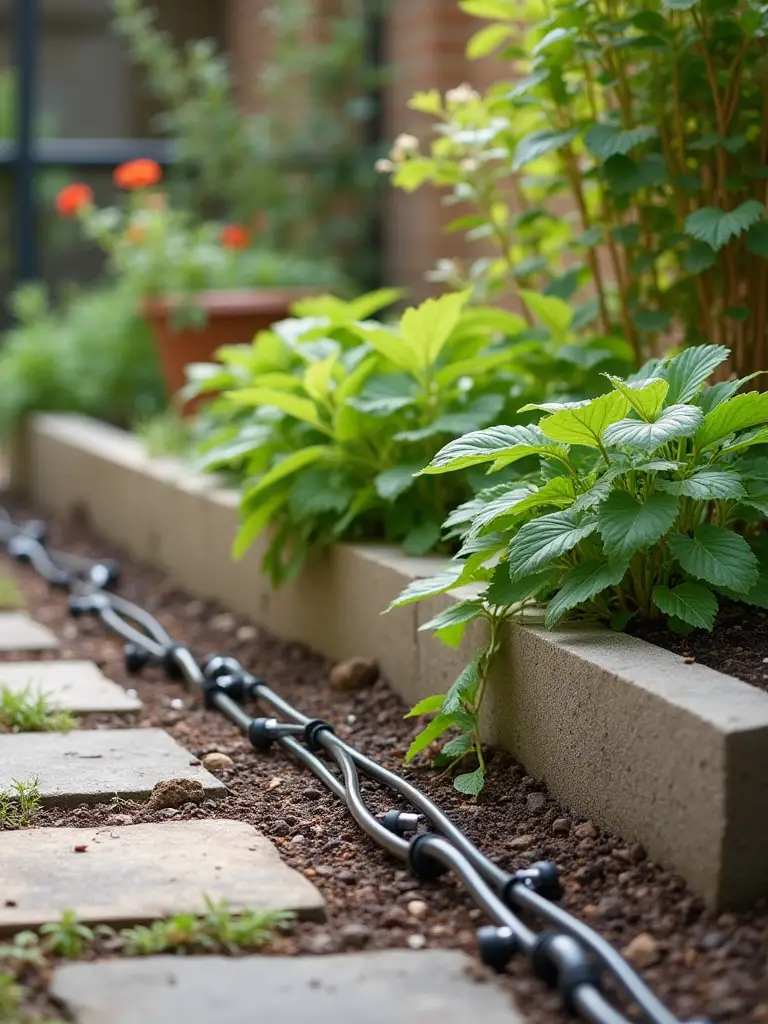
Plan your irrigation layout by sketching patio dimensions and marking each container location relative to water sources. Calculate required tubing lengths and emitter quantities based on plant types and container sizes – typically one emitter per pot positioned centrally near plant bases. Purchase complete starter kits including main tubing, feeder lines, various emitters, pressure regulators, filters, and programmable timers to ensure component compatibility and system reliability.
Installation involves connecting pressure regulators and filters to outdoor spigots, laying main tubing secured with stakes, and inserting feeder lines to individual plants with appropriate emitters. Test systems thoroughly for leaks and proper water distribution, adjusting emitter placement or quantities as needed. Program timers for optimal watering duration and frequency based on plant requirements and climate conditions. A busy professional installed a basic drip system with timer for their 8-container balcony garden, achieving 95% reduction in daily watering time while observing 30% increased herb yields due to consistent moisture availability.
- System components: Main tubing, feeder lines, emitters, pressure regulators, filters, timers
- Efficiency benefits: 90% water use efficiency, reduced evaporation, consistent moisture delivery
- Maintenance requirements: Regular leak checks, emitter cleaning, seasonal system adjustments
The traditional methods used result in healthier gardens when you embrace companion planting principles that support natural plant relationships.
18. Harness Natural Plant Partnerships Through Companion Planting
Companion planting utilizes natural plant relationships to enhance growth, deter pests, and improve soil health through strategic species placement that mimics beneficial ecosystem interactions. This time-tested approach reduces reliance on chemical interventions while creating more resilient, productive gardens that support biodiversity and natural pest management. Research demonstrates 15-40% reduction in pest populations when repellent plants like marigolds or nasturtiums are grown near susceptible crops, highlighting the practical benefits of thoughtful plant partnerships.
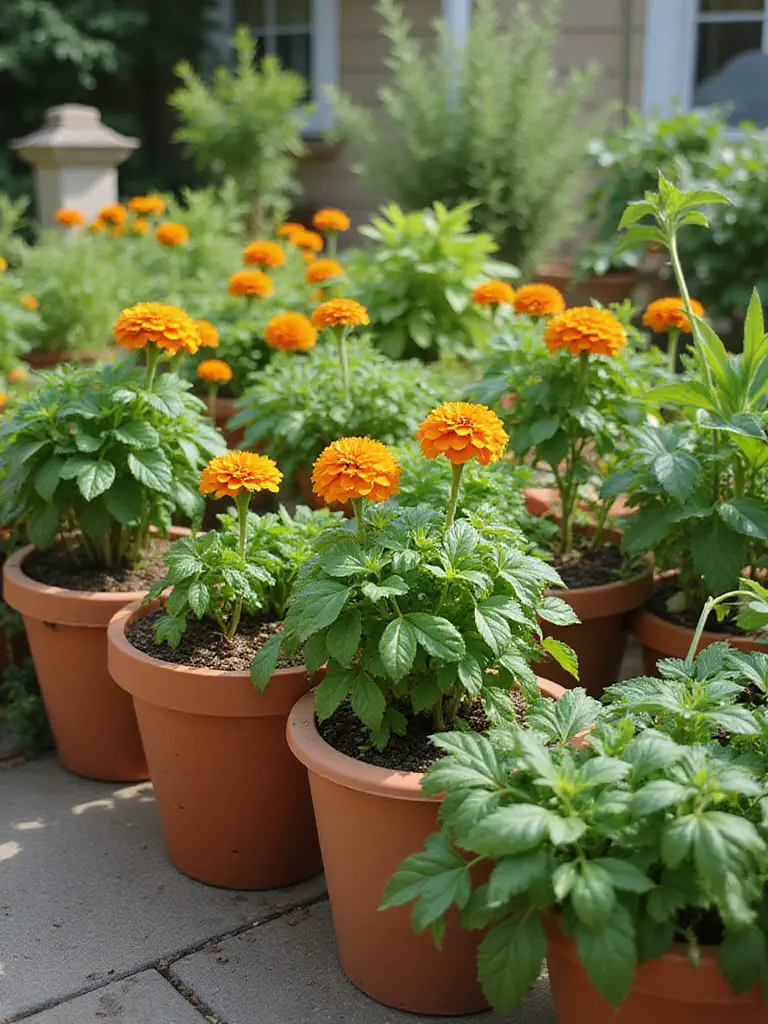
Research compatible plant combinations that offer mutual benefits – classic pairings include basil with tomatoes for improved flavor and pest deterrence, marigolds with vegetables for nematode control, and nasturtiums with brassicas as trap crops for aphids and cabbage worms. Consider each plant’s mature size, root depth, and resource requirements to prevent competition while maximizing beneficial interactions. Group plants with similar sun, water, and soil needs to simplify care while supporting natural partnerships.
Plan container arrangements or interplanting strategies that accommodate companion relationships within patio space constraints. Larger containers can house multiple compatible species, while smaller pots can be strategically grouped to achieve beneficial effects. A patio gardener successfully combined cherry tomatoes with basil in large containers while using marigolds in surrounding pots to create a natural pest management system that reduced aphid problems by an estimated 85% while improving tomato flavor and yield.
- Classic combinations: Basil with tomatoes, marigolds with vegetables, nasturtiums with brassicas
- Pest management: Trap crops, repellent plants, beneficial insect attractors
- Space considerations: Container interplanting, strategic pot grouping, vertical companion arrangements
The cultural heritage preserved in each piece includes attracting beneficial insects that support both garden health and local ecosystems.
19. Support Ecosystems by Attracting Beneficial Pollinators
Creating pollinator-friendly patio gardens supports declining beneficial insect populations while directly improving plant health, bloom production, and edible crop yields through enhanced pollination services. More than 75% of global food crops depend on animal pollinators, with native bees being particularly crucial for local ecosystem health. Even small patio gardens can create vital urban habitat corridors that support biodiversity while providing educational opportunities and deeper connections with natural processes.
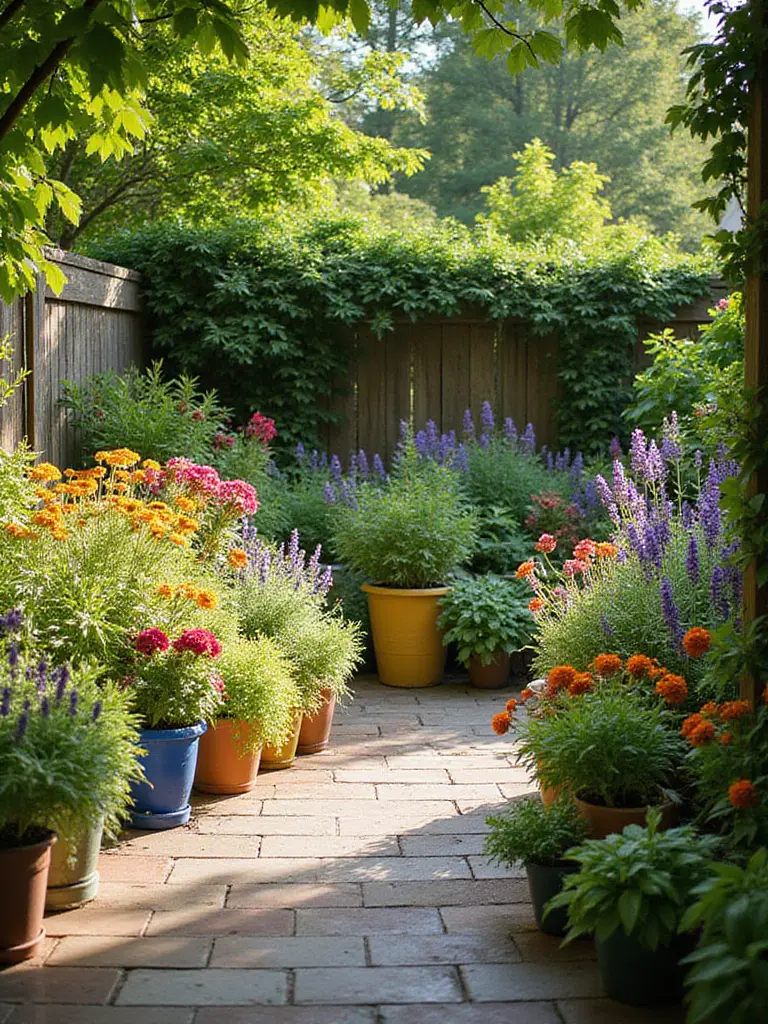
Prioritize native flowering plants adapted to your regional climate that provide optimal nectar, pollen, and host resources for local pollinator species. Research native plant nurseries and select varieties with different bloom times to ensure continuous food sources throughout growing seasons. Excellent choices include native salvias, coneflowers, bee balm, and regional wildflowers that support both specialist and generalist pollinator species while requiring minimal maintenance once established.
Provide shallow water sources using dishes with pebbles or marbles that allow insects to drink safely without drowning, changing water regularly to prevent mosquito breeding. Eliminate pesticide use entirely, as these chemicals are highly toxic to beneficial insects even in small quantities. Include nesting habitat through small log sections, hollow stem bundles, or purchased “bee hotels” that support solitary bee species. A 100-square-foot Chicago rooftop garden featuring 80% native plants documented 60% increase in native bee species and 45% increase in butterfly visits within two seasons.
- Native plant priorities: Regional wildflowers, native salvias, coneflowers, bee balm, asters
- Habitat features: Shallow water sources, nesting sites, overwintering shelter, pesticide-free environment
- Seasonal considerations: Continuous bloom succession, fall cleanup delays, winter habitat retention
The revival of this classic form comes with a twist: planning for year-round visual interest that transcends single-season displays.
20. Design for Continuous Seasonal Interest and Color
Strategic seasonal planning ensures patio gardens remain visually engaging throughout the year by incorporating plants that offer different types of interest across all seasons, from spring bulbs through winter evergreens. This approach moves beyond single-season flower displays to create dynamic landscapes that provide continuous reasons to enjoy outdoor spaces regardless of weather or time of year. Well-planned seasonal gardens can increase perceived property value by 7-15% while extending patio usability and enjoyment across all seasons.
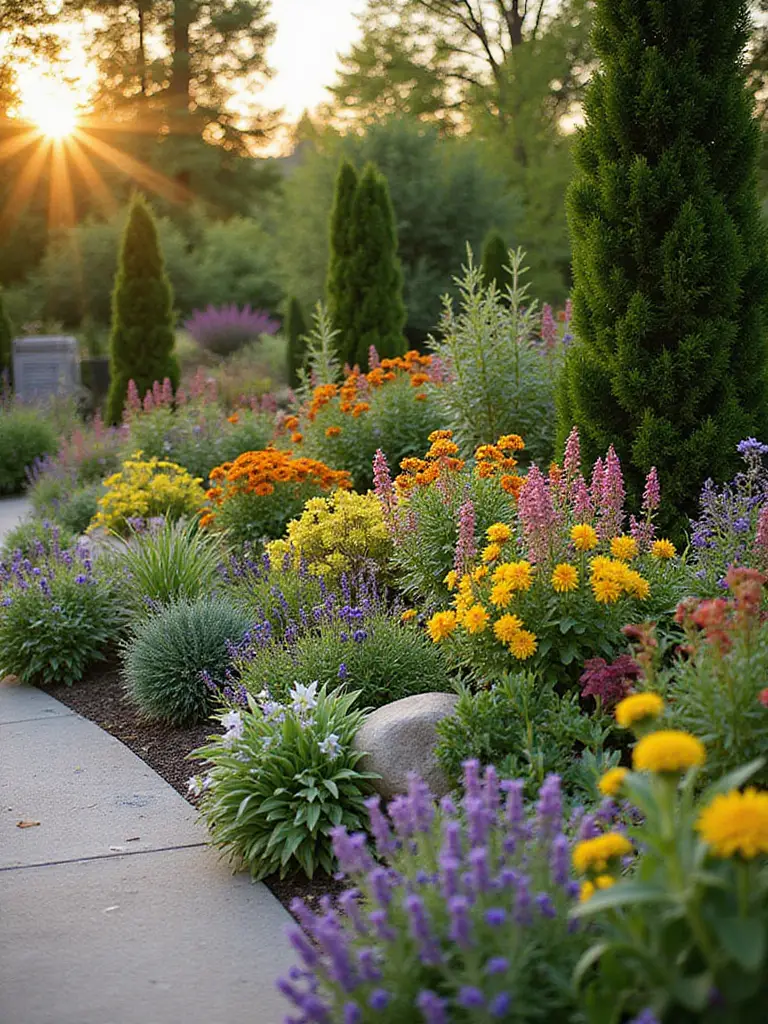
Select diverse plant categories that contribute different seasonal elements: spring bulbs for early color, summer annuals for peak blooms, fall perennials for late-season interest, and evergreens for winter structure. Include plants with interesting bark, seed heads, or foliage that changes color seasonally to maintain visual appeal when flowers aren’t present. Consider succession planting schedules where certain plants fade as others reach their prime, ensuring continuous displays without gaps.
Plan container arrangements that can accommodate seasonal transitions through plant replacement or strategic positioning of seasonal elements. A patio in USDA Zone 7 features a large central container that progresses from spring tulips and pansies to summer petunias and calibrachoa, then autumn ornamental kale and mums, finally winter dwarf conifers and winterberries. This provides year-round color and texture while maximizing the impact of limited space through carefully timed seasonal transitions.
- Spring elements: Bulbs, early perennials, flowering trees, fresh foliage emergence
- Summer features: Peak blooming annuals, lush foliage, fruit and vegetable harvests
- Fall interest: Changing foliage colors, late-blooming perennials, ornamental grasses, seed heads
- Winter structure: Evergreens, interesting bark, persistent berries, architectural plant forms
Unlike conventional options, this approach reduces pest problems through integrated management strategies that protect plants naturally.
21. Protect Plants Through Integrated Organic Pest Management
Smart pest control emphasizes prevention and organic management strategies that protect plant health while safeguarding beneficial insects, family members, and pets from harmful chemical exposure. Integrated Pest Management (IPM) principles prioritize cultural practices, biological controls, and targeted organic treatments as sustainable alternatives to broad-spectrum pesticides. Research shows diverse plant communities supporting beneficial insects can reduce pest damage by an average of 40% compared to monoculture plantings, highlighting the importance of ecological approaches.
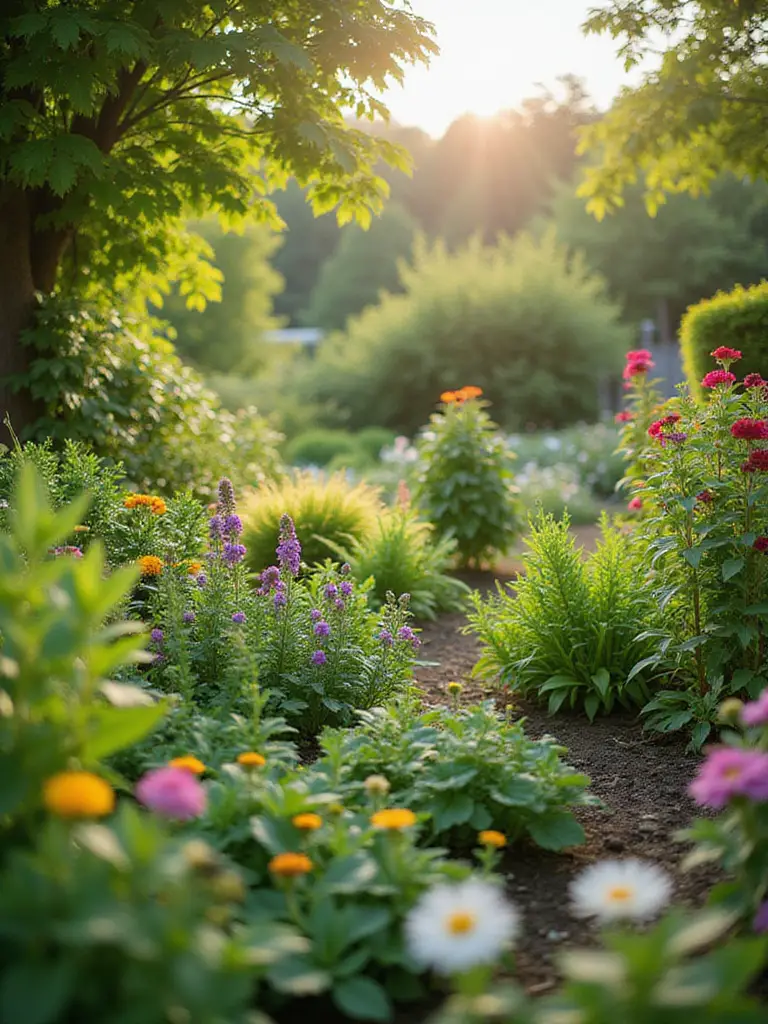
Implement regular monitoring routines that check plants twice weekly for early pest detection, focusing on leaf undersides and new growth where problems typically begin. Early intervention allows for minimal, targeted responses before infestations escalate. Promote beneficial insects through pollinator-friendly plantings and avoiding pesticide use – natural predators like ladybugs, lacewings, and parasitic wasps provide effective biological control when their habitat needs are met.
Employ organic treatment options for existing problems: insecticidal soap for soft-bodied pests like aphids, neem oil for feeding disruption, and horticultural oils for various pest types. Always test treatments on small plant areas first and apply during cooler parts of the day to prevent plant damage. A Seattle patio gardener addressed persistent aphid problems by introducing beneficial insects and planting sweet alyssum to attract natural predators, achieving 85% aphid reduction within two weeks while establishing long-term biological control.
- Prevention strategies: Healthy plant culture, proper spacing, appropriate plant selection, regular monitoring
- Biological controls: Beneficial insect habitat, natural predator encouragement, companion planting
- Organic treatments: Insecticidal soap, neem oil, horticultural oils, targeted applications
Conclusion
Transforming your patio into a thriving garden sanctuary represents more than simple decoration – it’s about creating a personal oasis that enhances daily life while connecting you with the natural world. These 21 patio garden ideas provide a comprehensive roadmap from initial space assessment through advanced techniques like companion planting and integrated pest management. Each strategy builds upon the others, creating layered approaches that maximize both beauty and functionality within your unique outdoor space.
The beauty of these patio garden ideas lies in their adaptability to any space, from expansive suburban decks to compact urban balconies. Whether you’re drawn to water-wise xeriscaping, productive edible gardens, or fragrant evening retreats, the fundamental principles remain consistent: understand your space, choose appropriate plants and materials, and create systems that support long-term success with minimal maintenance. The investment in thoughtful patio garden design pays dividends through increased property value, reduced stress, fresh food production, and countless hours of outdoor enjoyment.
Your patio transformation journey begins with a single step – perhaps assessing your space’s light patterns or selecting your first quality containers. Start with the patio garden ideas that resonate most strongly with your vision and gradually build complexity as your confidence and experience grow. Remember that the most successful gardens evolve over time, reflecting both changing seasons and your developing relationship with your outdoor space. Your dream patio garden awaits, ready to become the natural sanctuary you’ve always envisioned.
